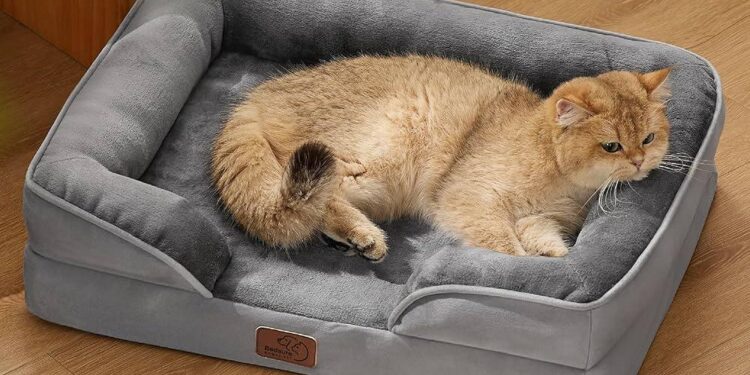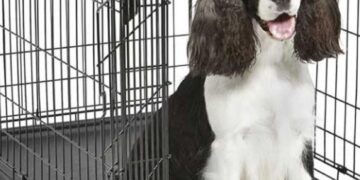Table of Contents
My journey into the heart of canine anxiety didn’t begin in a sterile laboratory or a university lecture hall.
It began on my living room floor, watching a small, trembling terrier mix named Barnaby.
I had adopted him a week earlier, bringing him home from a local rescue with a heart full of hope and a head full of clinical knowledge.
As a veterinary behavior researcher, I thought I was uniquely equipped to help him navigate his new life.
He was a textbook case of anxiety: the constant panting, the frantic pacing whenever I picked up my keys, the way a distant rumble of thunder would send him scrambling for cover.1
My first, and as it turned out, most telling mistake was to project my human understanding of comfort onto him.
I invested in a state-of-the-art, flat, memory foam orthopedic bed.
It was plush, supportive, and scientifically engineered for joint health—the canine equivalent of a luxury mattress.
I proudly placed it in the corner of the living room, expecting him to gratefully sink into its embrace.
He never touched it.
Not once.
Instead, I would find him wedged into the most uncomfortable-seeming places imaginable: crammed behind the sofa, shivering under the narrow gap of my desk, or curled so tightly in an old cardboard box he looked like a pretzel.
My expensive, logical solution lay ignored while Barnaby, driven by a force I had clearly underestimated, sought solace in confinement and pressure.
That failure was both a professional embarrassment and a personal heartbreak.
It forced me to abandon my assumptions and ask a new, more profound question: What if true canine comfort has nothing to do with soft surfaces and everything to do with psychological security? My quest to answer that question for Barnaby led me to re-evaluate everything I thought I knew about a dog’s needs and, eventually, to the unassuming, fluffy donut that is the subject of this analysis.
The Paradigm Shift: Why “Soft” Isn’t Enough for an Anxious Dog
The pet product industry has long operated under a simple, yet flawed, paradigm: canine comfort is primarily a physical state.
This has given us a market saturated with beds that are essentially miniature human mattresses—flat, open, and focused on orthopedic support.
For a confident, well-adjusted dog, this may be sufficient.
But for an anxious dog like Barnaby, this model fails because it ignores the fundamental driver of their behavior: the need for psychological security, a need rooted in deep, primal instincts.
Pillar 1: Understanding the Anxious Canine Mind
Canine anxiety is not a training issue or a personality quirk; it is a state of physiological and psychological distress.
The symptoms can be dramatic and destructive, such as incessant barking, chewing furniture, or soiling in the house.3
These are often the signs that prompt an owner to seek help.
However, many of the most common indicators are far more subtle.
An anxious dog may exhibit constant panting even when cool, lick their lips when not thirsty, show the whites of their eyes (a phenomenon known as “whale eye”), or tremble uncontrollably.1
They may also engage in what are called “displacement behaviors”—normal actions performed out of context as a way to cope with stress.
These include yawning when not tired, sneezing when there’s no irritant, or suddenly becoming intensely interested in sniffing the ground for no apparent reason.2
The causes are as varied as the symptoms.
For many, like rescue dogs, it stems from past trauma or abandonment.
For others, it can be triggered by specific fears like loud noises from thunderstorms and fireworks, or a generalized separation anxiety that kicks in the moment their human prepares to leave.1
Barnaby’s frantic search for tight spaces was not a rejection of the comfort I offered, but a desperate, instinctual attempt to self-soothe his overstimulated nervous system.
Pillar 2: The Primal Power of the Denning Instinct
To understand why Barnaby rejected a soft bed for a tight space, we must look past his life as a domesticated pet and into the ancient brain he shares with his wild ancestors.
Dogs are, by nature, den animals.6
For wild canids, a den is a sanctuary—a secure, enclosed space that offers protection from predators and the elements.
It is a place of ultimate safety where they can rest, heal, and raise their young.7
This powerful denning instinct has not been bred out of our modern companions.
It manifests every time a dog scratches at its bed before lying down, burrows under a pile of blankets, or, in Barnaby’s case, seeks out the most cave-like space in a home.8
Providing a dog with a space that fulfills this need is not an indulgence; it is a biological necessity for their mental well-being.
A personal, secure space reduces stress, promotes healthy independence, and gives them a safe retreat from the overwhelming stimuli of a busy household.11
The failure of traditional flat beds for anxious dogs is therefore a design flaw born from a profound misunderstanding of what a dog truly needs.
We have been building them miniature versions of our own beds, assuming their needs mirror ours.
But an open, exposed mattress offers zero psychological security to an animal that is hardwired to seek an enclosed, protective den.
Barnaby wasn’t being difficult; he was trying to build the sanctuary I had failed to provide.
| Canine Anxiety Symptom Checklist | ||
| Overt Behaviors | Subtle Body Language | Displacement Cues |
| Destructive chewing/digging 3 | Panting when not hot 2 | Yawning when not tired 2 |
| Excessive barking or howling 4 | Trembling or shivering 5 | Lip licking or nose licking 1 |
| Inappropriate urination/defecation 2 | Pacing or restlessness 5 | Sudden, intense ground sniffing 2 |
| Aggression (growling, snapping) 3 | Tucked tail 5 | Rapid blinking 2 |
| Attempts to escape 4 | Ears pulled back 1 | “Shaking it off” after a neutral event 5 |
| Clinginess or “velcro” behavior 13 | Whites of eyes showing (“whale eye”) 2 | Stretching when not stiff 2 |
The Epiphany: Unlocking Canine Calm with Human Therapeutic Science
My breakthrough with Barnaby came when I stopped looking for answers in the world of pet products and turned instead to the field of human occupational therapy.
It was there, in the research on sensory processing disorders, that I discovered the work of Dr. Temple Grandin and the transformative power of a concept called Deep Pressure Stimulation (DPS).
Explaining Deep Pressure Stimulation (DPS): The Science of the “Hug”
Deep Pressure Stimulation is the therapeutic application of firm, constant, and gentle pressure to the body.
Its effect is not just psychological; it is profoundly physiological.
This pressure helps switch the autonomic nervous system from its sympathetic state—the “fight or flight” response responsible for feelings of anxiety and high alert—to its parasympathetic state, the “rest and digest” mode that promotes calm and relaxation.14
This neurological switch triggers a cascade of beneficial biochemical changes.
It helps lower the body’s levels of cortisol, the primary stress hormone, while simultaneously boosting the production of serotonin and dopamine.
These are often called the “feel-good” neurotransmitters, and they are crucial for mood regulation, feelings of happiness, and restful sleep.15
In essence, DPS is the science behind why a firm hug feels so calming.
Drawing Powerful Parallels from Human Therapy
The application of DPS is a well-established practice in human therapy, and its principles are visible in several common practices:
- Swaddling Infants: The age-old practice of swaddling a baby is a perfect example of DPS. The snug wrap does more than just restrict movement; it recreates the constant, secure pressure of the womb.18 This proprioceptive input calms their nervous system, reduces the startling reflex, and helps them feel safe, leading to longer, more restful sleep.19
- Weighted Blankets: A modern application of DPS, weighted blankets are now widely used to help adults and children with anxiety, insomnia, autism, and ADHD.22 By distributing a gentle, constant weight across the body, these blankets simulate the feeling of being held or hugged, which can lower heart rate, ease restlessness, and promote the release of calming neurotransmitters.17
- Dr. Temple Grandin’s “Hug Machine”: Perhaps the most compelling evidence comes from Dr. Temple Grandin, a renowned animal scientist who is also autistic. As a child, she craved the sensation of deep pressure but found human hugs to be overstimulating and unbearable. Inspired by the calming effect she observed when cattle were guided through squeeze chutes on her aunt’s ranch, she invented the “Hug Machine”—a device that allowed her to self-administer the calming deep pressure she needed.26 Her invention was revolutionary, providing concrete proof that mechanical pressure could be profoundly therapeutic for an over-stimulated nervous system, reducing anxiety and tension.28
This was my “eureka” moment.
The common thread connecting a swaddled baby, an adult under a weighted blanket, and Dr. Grandin in her hug machine was the same calming principle.
And I realized that the Best Friends by Sheri Donut Bed was not just a piece of pet furniture.
It is a brilliantly designed, passive, canine-centric DPS delivery system. Its effectiveness is not a marketing gimmick; it is the result of a design that perfectly translates a proven human therapeutic concept into a form that aligns with a dog’s most fundamental biological and psychological needs.
It simultaneously satisfies the behavioral drive for a den and the neurological need for deep pressure.
Anatomy of a Calming Device: How the Donut Bed Delivers Psychological Security
Armed with this new framework, I looked at the donut bed not as a bed, but as a therapeutic tool.
I ordered one for Barnaby, and its effect was immediate and profound.
He approached it cautiously, circled it three times, pawed at the center, and then curled up inside, letting out a deep sigh as his body pressed against the raised walls.
He fell into the first truly peaceful sleep I had seen him have.
Each feature of the bed, I now understood, was a deliberate component in a sophisticated calming system.
Feature 1: The Round Shape & Raised Rim – The Core of the “Hug”
The bed’s signature feature is its circular shape with a high, bolstered rim.
This is the primary mechanism for delivering both the den-like enclosure and the Deep Pressure Stimulation.
The round shape encourages a dog’s natural instinct to curl up, a position of vulnerability they only assume when they feel completely secure.30
As the dog settles in, the soft but firm raised rim presses gently against their back, sides, and neck.
This constant, reassuring contact mimics the feeling of being held or cuddled by their mother and littermates, activating the parasympathetic nervous system and triggering that calming chemical cascade.33
It is, in effect, a gentle, passive, all-night hug.
Feature 2: The Vegan Shag Fur – Mimicking Maternal Comfort
The tactile experience of the bed is crucial.
The surface is covered in a long, soft, vegan shag fur.
This is not merely a decorative choice.
It is specifically designed to be reminiscent of a mother dog’s fur coat.30
This taps into one of a puppy’s earliest and most powerful sensory memories of safety, warmth, and comfort, providing a powerful, non-verbal cue to the dog’s brain that this is a safe space.30
This soothing tactile input works in concert with the deep pressure to further calm an anxious mind.
Feature 3: The Deep Crevices – Enabling Self-Soothing Behavior
A key element of the denning instinct is the act of “nesting”—digging, pawing, and arranging a sleeping area to make it just right.9
The donut bed’s design accommodates this self-soothing behavior perfectly.
The construction includes deep crevices and folds in the fabric, allowing a dog to burrow, nuzzle, and hide part of their body, giving them a sense of control over their environment.30
The bed doesn’t just provide a pre-made den; it provides a customizable den that the dog can actively shape to maximize their own sense of security.
Feature 4: The AirLoft™ Fiber Filling – The Engine of the Device
While the shape and materials are key, the bed’s long-term therapeutic efficacy depends entirely on its filling.
Best Friends by Sheri uses a proprietary poly filling called AirLoft™ fibers, which are engineered to keep their loft and resilience up to three times longer than the filling in standard pet beds.30
In the context of the Psychological Security paradigm, this is the most critical structural component.
The filling’s job is not just to be soft; its primary function is to support the raised walls.
If the filling were to flatten and collapse, the walls would sag, and the bed would lose its ability to provide the constant, enclosing pressure of DPS.
A flat wall is a failed therapeutic mechanism.
Therefore, the quality and durability of the fill are directly proportional to the bed’s ability to deliver its calming benefits over time.
| BFbS Donut Bed: Feature-to-Mechanism Analysis | ||
| Feature | Behavioral Principle (Psychology) | Neurological Mechanism (Physiology) |
| Round Shape & Raised Rim | Fulfills the primal denning instinct by creating a secure, enclosed, cave-like space.7 | Delivers Deep Pressure Stimulation (DPS), simulating a hug to calm the nervous system.15 |
| Vegan Shag Fur | Taps into early sensory memory by mimicking a mother’s fur coat, signaling safety and comfort.30 | Provides positive tactile stimulation, which is inherently soothing and reduces stress hormones.18 |
| Deep Crevices | Enables instinctive “nesting” and burrowing behaviors, allowing the dog to self-soothe and customize its den.9 | Promotes a sense of control and agency over the environment, which reduces anxiety.12 |
| AirLoft™ Fiber Filling | Maintains the structural integrity of the den, preventing the walls from collapsing and preserving the sense of security.30 | Ensures consistent and reliable delivery of Deep Pressure Stimulation over the lifespan of the product. |
The Real-World Application: Is the Best Friends by Sheri Bed Right for Your Dog?
Understanding the science behind the donut bed is the first step.
The second is determining if it’s the right tool for your specific dog and household.
While it can be a transformative product, it is not a universal solution.
The Ideal Canine Candidate
This bed is most effective for dogs exhibiting signs of mild to moderate anxiety.
This includes:
- Dogs with Separation Anxiety: It provides a secure “safe space” for them to retreat to when you are away.36
- Dogs with Noise Phobias: During thunderstorms or fireworks, the enclosing design can help muffle sound and provide a comforting refuge.35
- Newly Adopted or Rescue Dogs: It offers a consistent, secure “home base” that can help them decompress and adjust to a new and potentially overwhelming environment.13
- Senior Dogs: Older dogs often experience increased anxiety due to cognitive decline or physical discomfort. The gentle pressure and soft support can be profoundly comforting for them.36
When to Be Cautious: The Non-Ideal Candidate
There is one major contraindication for this bed: destructive chewing. The very features that make it so comforting—the soft shag fur and plush filling—can make it an irresistible target for a dog that chews out of boredom, anxiety, or habit.
A negative review highlighted a lack of durability when faced with a determined pet, and the manufacturer itself notes that the bed is not a chew toy.33
If your dog is a heavy or destructive chewer, it is crucial to address that behavior through training and management before investing in this bed, or to opt for a more durable, chew-resistant design.
Sizing is Critical for Efficacy
Choosing the right size is not about giving your dog the most space possible; it is about ensuring the therapeutic mechanism can function correctly.
For the Deep Pressure Stimulation to work, the dog’s body must be able to press against the raised rim.
A bed that is too large will feel open and exposed, completely defeating the purpose of the enclosing design.
The goal is a snug, cozy fit that allows the dog to feel enveloped.
Always measure your dog and consult the manufacturer’s weight and breed recommendations before purchasing.
| Official Sizing and Breed Guide | ||
| Bed Size (Diameter) | Recommended Pet Weight | Example Breeds |
| 17 inches | Up to 15 lbs | Chihuahua, Small Cats |
| 23 inches | Up to 25 lbs | Shih Tzu, Pomeranian, French Bulldog, Pug 30 |
| 30 inches | Up to 45 lbs | Corgi, Beagle Mixes 30 |
| 36 inches | Up to 100 lbs | Labrador, Golden Retriever, Pit Bull Mixes 31 |
| 45 inches | Up to 150 lbs | German Shepherd, Greyhound, Great Dane 31 |
Maintenance and Longevity
To preserve the bed’s therapeutic properties, proper care is essential.
The entire bed (for smaller sizes) or the removable cover (for medium and larger sizes) is machine washable.31
However, the drying process is critical.
The instructions explicitly warn
not to air dry the bed, as this will cause the long shag fur to become tangled and matted, ruining the soft, comforting texture.33
To maintain its fluff and loft, it must be tumbled dry on a low heat setting.
The water- and dirt-resistant bottom helps prevent minor accidents from soaking through to your floors, adding a practical layer of convenience.30
The Final Verdict: More Than a Bed, It’s a Behavioral Tool
The success of the Best Friends by Sheri Donut Bed is not accidental.
It is a triumph of design that intuitively—or intentionally—applies sophisticated principles from behavioral science and human therapy to solve a common canine problem.
It operates on the paradigm of Psychological Security, addressing the root cause of much anxiety—the unmet, primal need for a secure den—in a way that flat, open beds simply cannot.
My journey with Barnaby came to a peaceful conclusion the day his donut bed arrived.
Watching him instinctively circle, nest, and settle into a deep, untroubled sleep was the ultimate validation.
The frantic energy that had defined his existence in my home finally dissipated, replaced by a quiet confidence.
He had found his sanctuary.
The bed didn’t “cure” his anxiety, but it gave him a powerful tool to manage it, a safe harbor in the storms of his nervous system.
My expert recommendation is therefore clear, but nuanced.
For dogs with mild to moderate anxiety who are not destructive chewers, the Best Friends by Sheri Donut Bed is one of the most effective and well-designed non-pharmaceutical calming tools available on the market. It is more than a comfortable place to sleep; it is an investment in your dog’s mental health, emotional well-being, and sense of security in the world.
However, for dogs who are heavy chewers, or for confident dogs who show no signs of anxiety, it may be an unnecessary expense with features that won’t be fully utilized.
The key to a successful purchase lies in understanding why this bed works and matching the tool to the specific needs of your individual dog.
The greatest lesson Barnaby taught me is one that extends far beyond pet products.
To truly care for our dogs, we must make an effort to see the world not as we do, but as they do.
We must learn to listen to their silent, instinctual language.
The best solutions are rarely the ones that appeal to our human sensibilities, but rather the ones that honor the ancient, wild, and wonderful nature of the animals we are so lucky to love.
Works cited
- Anxious behavior: How to help your dog cope with unsettling situations, accessed August 16, 2025, https://www.vet.cornell.edu/departments-centers-and-institutes/riney-canine-health-center/canine-health-information/anxious-behavior-how-help-your-dog-cope-unsettling-situations
- Anxiety in Dogs | Cummings School of Veterinary Medicine, accessed August 16, 2025, https://vet.tufts.edu/news-events/news/anxiety-dogs
- Signs of Anxiety in Dogs: Symptoms, Causes, and How to Help, accessed August 16, 2025, https://victoriaroadvet.com/does-your-pooch-have-anxiety/
- Dog Anxiety: Symptoms, Causes, and Treatment Options – GoodRx, accessed August 16, 2025, https://www.goodrx.com/pet-health/dog/anxiety-symptoms
- Signs your dog is feeling anxious | Dogs Trust, accessed August 16, 2025, https://www.dogstrust.org.uk/dog-advice/understanding-your-dog/signs-your-dog-may-be-stressed
- Dog Dens – American Humane Society, accessed August 16, 2025, https://www.americanhumane.org/public-education/dog-dens/
- Why Every Dog Needs a Den | ZenCrate, accessed August 16, 2025, https://zendogcrate.com/blogs/news/why-every-dog-needs-a-den
- Why Do Dogs Scratch Their Beds? – Primo Pads, accessed August 16, 2025, https://primopads.com/why-do-dogs-scratch-their-beds/
- Why is my dog digging in her bed? – Wag!, accessed August 16, 2025, https://wagwalking.com/symptom/why-is-my-dog-digging-in-her-bed
- Why Do Dogs Dig In Their Beds? – BARK Post, accessed August 16, 2025, https://post.bark.co/health/why-do-dogs-dig-in-their-beds/
- Why Every Dog Needs Its Own Space | Loyalist Barkway, accessed August 16, 2025, https://dogboardingkennels.ca/why-every-dog-needs-its-own-space/
- The Five Essentials for Your Dog’s Safe Space and Why They Need One | Paw CBD, accessed August 16, 2025, https://www.pawcbd.com/blogs/posts/the-five-essentials-for-your-dog-safe-space-and-why-they-need-one
- 5 Types of Calming Dog Beds for Adopted Dogs – 24Petwatch, accessed August 16, 2025, https://www.24petwatch.com/blog/5-types-of-calming-dog-beds-for-adopted-dogs
- What is deep pressure and how can it help my child? – Kids That Go, accessed August 16, 2025, https://kidsthatgo.com/what-is-deep-pressure-and-how-can-it-help-my-child/
- Deep Pressure Sensory Input: Understanding the Benefits and Neurochemistry, accessed August 16, 2025, https://communikidsnj.com/deep-pressure-sensory-input-understanding-the-benefits-and-neurochemistry/
- What is Deep Pressure Stimulation? Touch Therapy for ASD!, accessed August 16, 2025, https://www.appliedbehavioranalysisedu.org/what-is-deep-pressure-stimulation/
- Mayo Clinic Minute: How weighted blankets may lift anxiety – YouTube, accessed August 16, 2025, https://www.youtube.com/watch?v=2wz6jMTEp0k
- The Science Behind Swaddling: Why Babies Love Being Cuddled – Babocush, accessed August 16, 2025, https://www.babocush.com/blogs/news/the-science-behind-swaddling-why-babies-love-being-cuddled
- Swaddling – Wikipedia, accessed August 16, 2025, https://en.wikipedia.org/wiki/Swaddling
- Swaddling: a systematic review – PubMed, accessed August 16, 2025, https://pubmed.ncbi.nlm.nih.gov/17908730/
- what you need to know about swaddling – Hey Sleepy Baby Blog, accessed August 16, 2025, https://heysleepybaby.com/what-to-know-about-swaddling/
- The effect of weighted blankets on sleep and related disorders: a brief review – PMC, accessed August 16, 2025, https://pmc.ncbi.nlm.nih.gov/articles/PMC11056563/
- Weighted Blankets: Benefits, Do They Work, and More – Healthline, accessed August 16, 2025, https://www.healthline.com/health/anxiety/do-weighted-blankets-work
- Can Weighted Blankets Help with Anxiety? – Geisinger, accessed August 16, 2025, https://www.geisinger.org/health-and-wellness/wellness-articles/2022/12/14/20/02/weighted-blankets-help-with-anxiety
- Weighted Blanket Benefits: Do They Work? – Cleveland Clinic Health Essentials, accessed August 16, 2025, https://health.clevelandclinic.org/weighted-blanket-benefits
- Hug machine – Wikipedia, accessed August 16, 2025, https://en.wikipedia.org/wiki/Hug_machine
- The Calming Effect: Temple Grandin – Bancroft, accessed August 16, 2025, https://www.bancroft.org/the-calming-effect-temple-grandin/
- Temple Grandin Hug Machine: How Did Weighted Blanket Research Begin? | TruHugs, accessed August 16, 2025, https://truhugs.com/research-science/do-weighted-blankets-work-temple-grandin-hugging-machine/
- Description and schematic details of the squeeze machine – Grandin.com, accessed August 16, 2025, https://www.grandin.com/inc/intro-squeeze.html
- The Original Calming Dog Bed, Shag Fur, 23″ x 23″ | Best Friends by …, accessed August 16, 2025, https://bestfriendsbysheri.com/products/the-original-calming-dog-bed-donut-cuddler-shag-fur-23×23
- The Original Calming Donut Dog Bed in Shag Fur – 45″x45″ | Best Friends by Sheri, accessed August 16, 2025, https://bestfriendsbysheri.com/products/the-original-calming-dog-bed-donut-cuddler-shag-fur-45×45
- Calming Donut Bed in Lux Fur – 23″x23″ – Best Friends by Sheri, accessed August 16, 2025, https://bestfriendsbysheri.com/products/donut-cuddler-cozy-dog-cat-bed-lux-fabric-size-23×23
- Best Friends By Sheri Donut Dog Bed Navy Calming Donut Bed – Hollywood Feed, accessed August 16, 2025, https://www.hollywoodfeed.com/p/101427/best-friends-by-sheri-donut-dog-bed-navy-calming-donut-bed
- Calming Dog Beds for Better Health | Best Friends by Sheri, accessed August 16, 2025, https://bestfriendsbysheri.com/collections/shop-dogs
- How a Calming Dog Bed Works – Mad Paws, accessed August 16, 2025, https://www.madpaws.com.au/blog/how-a-calming-dog-bed-works/
- Do Calming Dog Beds Really Work? Vet-Verified Facts to Know – Dogster, accessed August 16, 2025, https://www.dogster.com/dog-health-care/do-calming-dog-beds-really-work
- The Original Calming Dog Bed Donut Cuddler™ | Best Friends by Sheri, accessed August 16, 2025, https://bestfriendsbysheri.com/collections/the-original-calming-donut-cuddler-dog-bed-in-shag-fur
- Best Friends by Sheri in the Press, accessed August 16, 2025, https://bestfriendsbysheri.com/pages/best-friends-by-sheri-in-the-press
- Best Friends By Sheri – Wayfair, accessed August 16, 2025, https://www.wayfair.com/brand/bnd/best-friends-by-sheri-b21230.html
- Do Calming Beds Work, and Should You Get One for Your Anxious Pup? – Rover.com, accessed August 16, 2025, https://www.rover.com/blog/do-calming-beds-work/
- veterinarypartner.vin.com, accessed August 16, 2025, https://veterinarypartner.vin.com/default.aspx?pid=19239&catId=254078&id=4952996#:~:text=There%20are%20many%20reasons%20an,poor%20adaptability%20to%20new%20situations.
- Best Friends by Sheri the Original Calming Donut Cat and Dog Bed in Shag Small – eBay, accessed August 16, 2025, https://www.ebay.com/itm/395409212570






